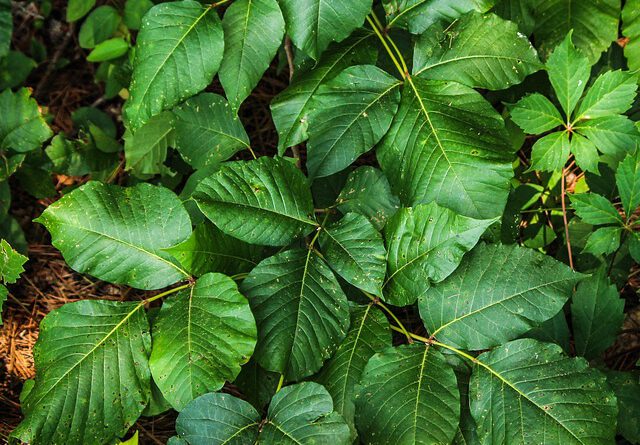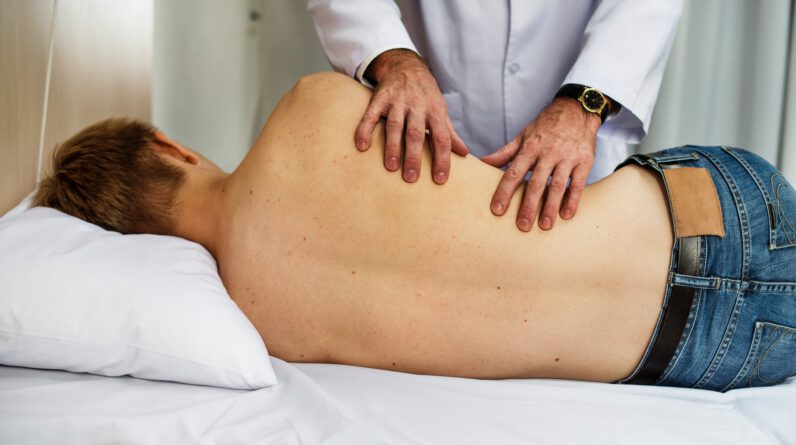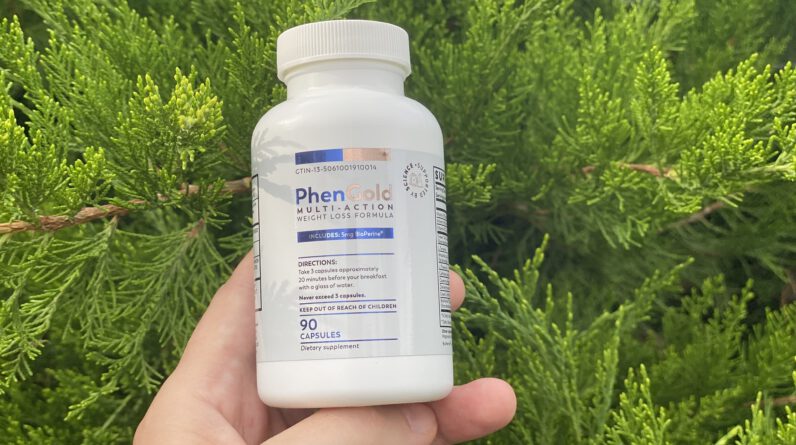
Did you know that 7 out of 10 people are allergic to poison ivy and that you can still contract poison ivy during the winter? Dealing with a poison ivy rash is irritating and for some people it puts them into the hospital.
The ingredient that causes the allergy is known as urushiol and it is a resin that is in poison ivy, poison oak and poison sumac. Because it is a resin it is very easy to make contact with it, all you have to do is literally brush against the plant to contract it.
For most people who are allergic to poison ivy the rash begins to develop in as little as two hours. Unfortunately it can take almost three weeks for this annoying rash to completely disappear.
You can develop a rash by touching anyone or an item that has been in contact with the poison ivy plant. If your dog has run through a clump of it and you pet your dog later on that day you can contract the skin rash. Even touching clothes will transfer the urushiol to your skin.
Being allergic to poison ivy is no fun at all and it is one of the most common forms of allergies in people today. In this report you will discover all you need to know about poison ivy and how to deal with it effectively.
Contracting Poison Ivy
Of course it makes sense to stay away from any patches of poison ivy but sometimes it is just unavoidable. It is important to learn how to identify poison ivy, and you should always keep the saying ‘leaves of 3 let it be’ in mind.
If you are not sure what the plant looks like check out the photo on this site:
Poison ivy grows as a low lying bush or as a vine and this is way it is often missed by hikers. It has three leaves coming off one branch and is often found amongst other weeds and smaller plants.
Poison ivy contains a resin called urushiol and this resin is found in the leaves, stem and roots of the plant. There are three main ways that you can contract the rash:
- By touching any part of the plant.
- By coming into contact with the plant by brushing up against it, touching a pet or touching clothing which has been contaminated.
- By inhaling poison ivy which is being burned as the smoke still contains the resin and if inhaled can irritate your lungs.
It is important to note that the urushiol is not contagious and neither are the blisters that form on your skin. The only way you can get poison ivy from another person is by touching their clothes.
Once the rash appears it will form tiny blisters on your skin which itch. It is important not to scratch them as they can become infected. If your blisters begin to pus it is recommended that you visit your doctor.
For the majority of people home remedies and treatments will help clear up a poison ivy rash. If you have a rash that is severe or one that lasts for more than two weeks you may need medical treatment. Most doctors will prescribe a course of an oral corticosteroid which will help clear up the condition.
How to Stop the Spread of Poison Ivy
Even if you think you may have come into contact with poison ivy you want to wash the clothes you are wearing. Remove your clothes and place them into your washing machine as this should remove all of the resin on the clothes.
As well you should rinse off any footwear you were wearing. The urushiol could be on your shoes or your shoe laces and touching them could transfer the resin to your skin.
While dogs and cats will not get the poison ivy rash they are well known for transferring the resin to their owners. If you have been out in the woods with your dog it is advisable to rinse or soap them off or just make a point of not touching them for a couple of days. If you do decide to bathe them use caution and wear gloves so that you don’t come into contact with the urushiol.
Poison Ivy Treatments
There are plenty of home remedies for poison ivy and we will go through the most popular ones below.
Cucumber slices – simply place slices of cucumber onto the rash. Or you can mash up the cucumber into a paste and then apply it to your skin.
Cold Milk – soak a wash cloth in cold milk and press it against your skin. This remedy works very well and is actually more soothing than using cold water.
Tea Bags – use a cold moist tea bag and apply it onto your rash. Tea contains tannic acid which is an astringent. This acid helps to reduce the inflammation in your tissues and helps to relieve the itch.
Banana Peel & Watermelon Rinds – both of these have been shown to help relieve the itch of a poison ivy rash. Make sure you use the inside of the banana peel and place it on the affected area.
Apple Cider Vinegar – this product has plenty of medicinal properties so it is no surprise that it can help a poison ivy rash. You can soak a cloth in the vinegar and then apply it over the rash. Some people have soaked brown paper bags and used that to cover the area. The properties in the vinegar help to draw out the toxins.
Baking Soda – this is really helpful to help draw out the toxins in the same way it does for treating pimples. You can make a paste of the baking soda and smear it on your skin. If you want to use it as a soothing agent then make a paste using a 3 to 1 ratio of baking soda to water.
Apply the paste and then allow it to dry on the skin, as it dries the baking soda will flake off. Some people have had luck by taking a warm bath and mixing in about 1 cup of baking soda.
Baking soda is a great way to treat blisters which are oozing. Use 1 quart of water with 2 teaspoons of baking soda and then soak sterile pads into the liquid. Cover your blisters with the moist pads and leave them on for 10 minutes. Repeat this at least 3 to 4 times per day.
Oatmeal – this has been used for a long time to soothe and treat skin conditions. If you find that your rash is spreading all over your skin taking an oatmeal bath can bring you lots of relief.
You can make an oatmeal pouch by grinding about 1 cup of oatmeal in your blender until it is fine and then wrap it in a piece of cheesecloth or a nylon stocking. Tie a knot in it and hang the pouch are your bath faucet so the water runs through the bag. Fill the tub with warm water and soak in it for half an hour. You can also use the moistened pouch directly onto your skin.
Aloe Vera – this is another soothing agent that helps irritated skin. You can use a store bought product and smear the gel onto your skin. Or if you have an aloe vera plant at home then use the gel from the leaves.
Rubbing Alcohol – use this to rub on your skin the moment you realize you may have come into contact with poison ivy. The rubbing alcohol can help minimize if not prevent the urushiol from sinking into your skin when used quickly. If you are planning on going hiking or camping you may want to pack a bottle of this to take with you.
Lemon Juice – this is known to be a natural astringent and many people find that it helps by cutting through the toxic oils in urushiol. Just like the rubbing alcohol it needs to be applied as soon as possible.
Soap & Water – this is one of the best home remedies and works if done quickly enough. As soon as you realize you have come into contact with poison ivy you want to wash the affected water with soap and water, plain water is good enough if no soap is available.
While the water may not completely protect you it will help reduce the severity of the rash. Do not use hot water as this opens up your pores and will allow more of the urushiol to penetrate into your skin.
Salt – taking a bath in salt helps to draw out excess body moisture repelling the poison from your body. Epsom salts in your bath will also help to provide you with relief from the rash.
Cold Compresses – these are really useful to use each time your rash starts to act up and is a much better remedy than scratching the blisters.
While all of the above remedies and home treatments can help you minimize the effects or poison ivy it is best to avoid it if at all possible. When using rubbing alcohol, lemon juice or soap and water you have approximately 15 minutes to get rid of the urushiol from your skin.
When washing your skin avoid using any type of washcloth as this could inadvertently spread the toxins over your body. Try to use a soap that does not contain any type of moisturizer.
If you are out camping or hiking and come into contact with poison ivy look for the nearest creek, river or lake and wash your body if possible. If not clean your skin with rubbing alcohol as soon as you can.
Over the Counter Remedies
Some people still prefer to choose a readymade over the counter product to treat poison ivy.
Calamine Lotion – this product works well at reducing the itching associated with poison ivy. It is a well known treatment for many skin conditions including providing relief from chicken pox. If your lotion is a little too thin it can be thickened up by adding a small amount of cornstarch.
Witch Hazel – use this with a cotton ball and pat onto the affected area.
Tea Tree Oil – it is possible to buy this at your local health store. To soothe a rash simply apply a small coating over the affected area.
The Best Way to Prevent Poison Ivy
If you are planning on going into any wooded area you should always be on the lookout for poison ivy. If you know you are allergic to it then it is advisable to wear long pants and a long sleeved shirt.
Educate yourself so that you know what poison ivy, oak and sumac all look like. Sometimes poison ivy grows like a vine and clings to large trees, so it may appear in unlikely places. Most people know that it is a small plant or bush but it can also creep along the ground as a vine.
During the spring poison ivy has leaves with a red color to them. Later on it produces pale white berries. It is possible to contract poison ivy in the winter as well. This is because it may have been wrapped around wood which is being used as firewood. While the plant may be dead the resin can still be transferred to your skin.
You can also develop poison ivy when burning leaves and brush in the fall. The oil can become airborne and get into your lungs. This can result in a serious lung infection, so be extremely cautious if you have asthma or sensitive lungs.
By preparing for any outdoor trips correctly and taking along a few supplies from home, you can be ready incase you do encounter any poison ivy or oak. Remember you only have a short time until the resin gets absorbed into your skin. If you think you have become infected with the poison ivy rash resist any temptation to touch other areas of your body, as this will spread the rash.







